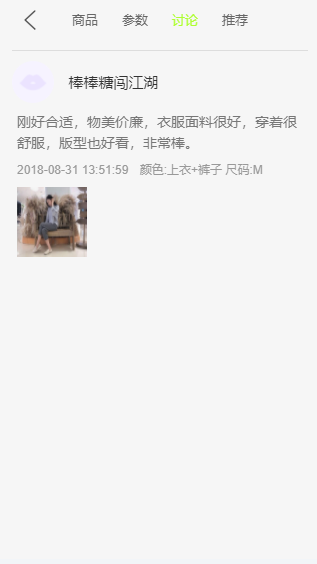已经实现了,点击详情页navbar的四个模块,会对应到每个商品中的相应位置。那么,我们现在想实现的是:比如滚到相应的尺寸模块或者评论时,navbar上的详情或者排列会自动变色。



这个,主要用了以下思路来实现:
首先,我们可以用一种很直观的方式来表达,首先先在scroll标签中设置probeType为3(因为在原来封装scroll的时候,将probeType的默认值设置为0,设置为3的时候可方便滚动且实时监听他的位置)
<scroll class="content" ref="scroll" @scroll="contentscroll" :probe-type="3">
之前在scroll.vue中曾经设置过监听滚动的位置的时候,发送出scroll事件,那么在此标签中,将监听contentscroll事件。
那么,接下来我们来讲述下contentscroll事件应该如何设计,首先是比较复杂的逻辑关系的设定。首先回顾下,我们把一个在data中初始化一个数组themeTopY,且在imageLoad中,每次都push了每个模块的offsetTop值。
data() { return { themeTopY:[0,0,0,0], currentIndex:0 } }
imageLoad() { this.refresh() // console.log("refresh no debounce") this.themeTopY =[ ] this.themeTopY.push(0) this.themeTopY.push(this.$refs.params.$el.offsetTop) this.themeTopY.push(this.$refs.comment.$el.offsetTop) this.themeTopY.push(this.$refs.recommend.$el.offsetTop) console.log(this.themeTopY) }
且,温故下原来封装的scroll:
<template> <div class="wrapper" ref="wrapper"> <div class="content"> <slot></slot> </div> </div> </template> <!--//ref如果是绑定在组件中的,那么通过this.$refs.refname获取到的是一个组件对象--> <!--//ref如果绑定在普通元素中,那么会通过this.$refs.refname获取的一个元素对象--> <script> import BScroll from "better-scroll" export default { name: "scroll", props:['probeType',"pullUpLoad"], //'pullUpLoad' data(){ return{ scroll:null } }, mounted(){ //1.创建BScroll对象 this.scroll = new BScroll(this.$refs.wrapper,{ click:true, probeType:this.probeType, pullUpLoad:this.pullUpLoad //监听滚动到底部 }) // this.scroll.scrollTo(0,0) //2.监听滚动的位置 this.scroll.on("scroll",(position)=>{ // console.log(position); this.$emit("scroll",position) }) //3.监听上拉加载事件 // this.scroll.on("pullingUp",()=>{ // this.$emit("pullingUp") // }) //监听滚动到底部 if(this.pullUpLoad){ this.scroll.on("pullingUp",()=>{ // console.log("监听"); this.$emit("pullingUp") }) } }, methods: { scrollTo(x, y, time = 1000) { this.scroll.scrollTo(x, y, time) }, // finishPullUp(){ // this.scroll.finishPullUp() // }, refresh() { // console.log("----1----"); this.scroll.refresh() }, finishPullUp() { }, // }, getScrollY() { return this.scroll ? this.scroll.y : 0 } } } </script> <style scoped> </style>
后期,我们来处理下detail.vue中的contentscroll事件:
contentscroll(position){ // console.log(position); const positionY = -position.y for(let i= 0;i<this.themeTopY.length;i++){ if(this.currentIndex !== i && i< this.themeTopY.length -1 && positionY >= this.themeTopY[i] && positionY < this.themeTopY[i+1] || (i === this.themeTopY.length - 1 && positionY > this.themeTopY[i])){ this.currentIndex = i; console.log(this.currentIndex); this.$refs.nav.currentIndex = i } }
解释下上述的代码:
首先,我们设定positionY为y轴上的position,由于其值在我测试后显示为负值,所以我直接在前面添加了一个负号。
之后,设置了一个for循环,设置i小于themeTopy的长度。之后,我主要做了一个或逻辑,来处理它。左边,我设置,i小于themeTopY的长度,且当positionY大于等于i的offsetTop值,小于下标i+1的offsetTop值的时候,
可以执行;或者i等于themeTopY的长度值减1的时候,也就是themeTopY的最后一个下标,且positionY大于最后一个数组元素的offsetTop时 ,也可以执行相应语句。之后,我在data中初始化了一个currentIndex,且在或逻辑的左边,设置当currentIndex的值不等于i的时候,才会执行相应左边的语句。之后,在执行时,我将i值赋予currentIndex,且将i值赋予navbar组件中的currentIndex值,我们再把detail中的navbar代码复现下:
e>
<div class="bbb">
<navbar>
<div slot="left" class="left" @click="backclick">
<img src="../../../src/assets/img/back.svg">
</div>
<div slot="center" class="title">
<div v-for="(item,index) in title"
class="aaa" :class="{active:index === currentIndex}" v-on:click="itemclick(index)">
{{item}}
</div>
</div>
</navbar>
</div>
</template>
<script>
import Navbar from "../../../src/components/common/navbar/navbar";
export default {
name: "detailnav",
components: {Navbar},
data(){
return{
title:['商品','参数','讨论','推荐'],
currentIndex:0
}
},
methods:{
itemclick(index){
this.currentIndex = index
this.$emit("itemclick",index)
},
backclick(){
this.$router.back()
}
}
}
</script>
<style scoped>
.title{
display: flex;
font-size: 13px;
}
.aaa{
flex: 1;
}
.active{
color: greenyellow;
}
.left img{
margin-top: 10px;
}
.bbb{
background-color: #f6f6f6;
/*height: 100vh;*/
}
</style>
那么,我们可以很清晰地发现,当事件中的i值赋予给navbar中的currentIndex,那么就可以实现滚动商品的四个详情模块的时候,亦可以实现滚动到哪个模块就激活navbar上的某个值。
这个方法的话,逻辑还是有点杂糅,还有个更为简单的方法。
我们可以在themeTopY这个数组的最后,直接push一个极大值,这样的话,直接在每个区间中执行就ok了,那我们来看下其代码实现。
imageLoad() { this.refresh() this.themeTopY =[ ] this.themeTopY.push(0) this.themeTopY.push(this.$refs.params.$el.offsetTop) this.themeTopY.push(this.$refs.comment.$el.offsetTop) this.themeTopY.push(this.$refs.recommend.$el.offsetTop) this.themeTopY.push(Number.MAX_VALUE) console.log(this.themeTopY) }
contentscroll(position) { // console.log(position); const positionY = -position.y for (let i = 0; i < this.themeTopY.length - 1; i++) { if (this.currentIndex !== i && (positionY >= this.themeTopY[i] && positionY < this.themeTopY[i + 1])) { this.currentIndex = i; // this.$refs.nav.currentIndex = this.currentIndex this.$refs.nav.currentIndex = i } } }
我们看下上述代码,当我在数组最后push进了一个极大值的时候,我的逻辑也可以实现的很为简洁了。首先,我们将i的值限制,限制其小于themeTop的长度-1,之后我们只需要,将positionY的值限制在大于等于数组中i位置的offsetTop且小于i+1的位置即可。
之后我们将i值赋予给nav中的currentIndex即可实现。